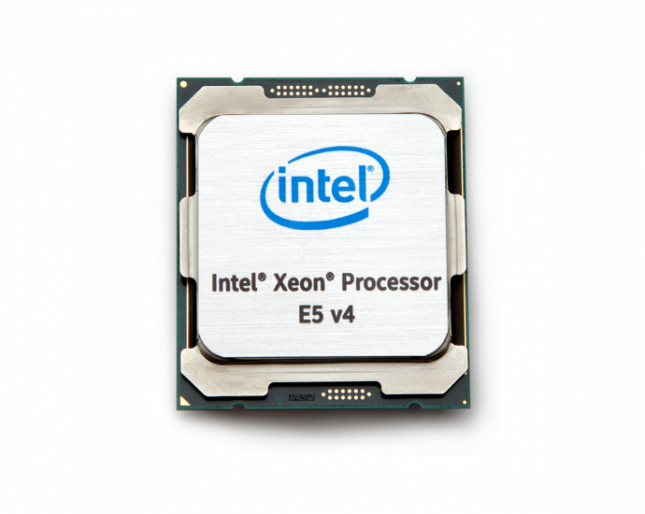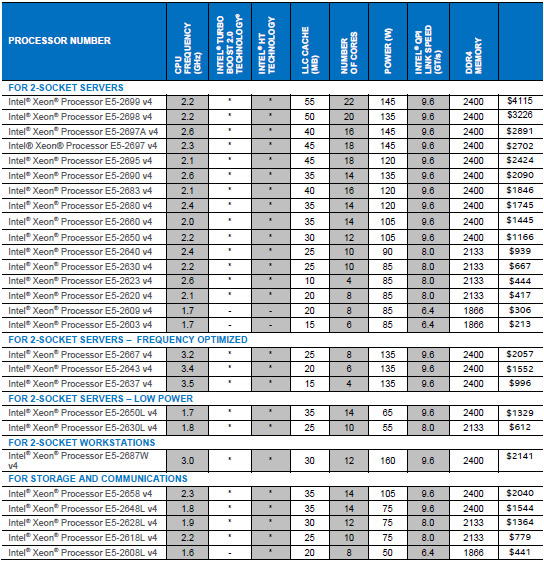Intel Xeon Processor E5-2600 v4 Product Family Announced With 27 Models!
Introducing the Intel Xeon Processor E5-2600 v4 Product Family
Driving the Digital Transformation in the Data Center with Improved Performance, Security and Agility
March 31, 2016 From individual servers and workstations to clusters, data centers, IoT and the cloud, the Intel Xeon processor E5-2600 v4 product family takes performance and efficiency to new heights1 across a wide range of workloads and provides an array of new technologies for more efficient virtualization, smarter resource orchestration, and enhanced protection of systems and data
Product Family Overview
Designed specifically for two-socket servers, the Intel Xeon processor E5-2600 v4 product family provides over 20 percent more cores and cache2 than the previous generation, supports faster memory, and includes integrated technologies that increase performance across a broad range of workloads3. The product family comes in a wide variety of configurations to allow core counts, frequencies and power levels to be tailored for individual workloads for optimal performance.The Intel Xeon processor E5-2600 v4 product family can help businesses, cloud service providers and telecommunications companies achieve higher performance and value from every new server, while accelerating the transition to software-defined infrastructure (SDI).
Advanced multi-core, multi-threaded processing
- Up to 22 cores and 44 threads per socket
Larger cache and faster memory
- Up to 55 MB of last-level cache (LLC) for fast access to frequently used data
- Up to 24 DIMMs per two-socket server to support multiple data-hungry VMs
- Faster maximum memory speeds than the previous generation (DDR4 2400 MHz versus 2133 MHz)
Higher performance for diverse workloads
- Intel Turbo Boost Technology with improvements when running mixed AVX workloads takes advantage of power and thermal headroom to increase processor frequencies across a wide range of workloads
- Improved virtualization performance, including lower latencies when entering and exiting VMs, less VM interrupts via posted interrupts, and page modification logging, which can be used for rapid VM check pointing
Higher performance for technical computing and multi-threaded applications
- Intel TSX instructions take advantage of hidden parallelism to accelerate OLTP and other multi-threaded workloads that experience bottlenecks due to memory locks
- Intel AVX2 instructions accelerate floating point and integer computations with support for 256-bit vectors. This technology can increase peak floating point operations by up to 31 percent6, and is now optimized for mixed workload environments
- The Intel Xeon processor E5-2600 v4 product family is Intels first processor within the Intel Scalable System Framework
Smarter Resource Orchestration
With the growth of private and hybrid clouds in the enterprise, IT organizations are deploying powerful new tools for orchestrating and automating data center resource management. The Intel Xeon processor E5-2600 v4 product family includes Intel Resource Director Technology, which provides deeper visibility and control over shared platform resources to enable smarter orchestration. This suite of technologies help IT organizations improve service levels and infrastructure utilization and accelerate their move toward fully automated SDI.
Intel Resource Director Technology includes:
- Cache monitoring and allocation technologies enable IT to make smarter scheduling and load balancing decisions, implement a new class of tiered services, and provide guaranteed cache for high priority applications
- Memory bandwidth monitoring helps IT balance workloads across sockets for optimized performance with enhanced utilization and improved service levels
- Intel Node Manager complements Intel Resource Director Technology by monitoring and controlling server power, thermals and utilization. In combination with Intel Data Center Manager, it enables IT to dynamically optimize energy consumption at every level, from individual servers, racks and rows to entire data centers
A Foundation for Trust and Security
The Intel Xeon Processor E5-2600 v4 product family adds additional layers of hardware-assisted security to help protect data and platforms more effectively through enhanced workload isolation, improved security policy enforcement and faster cryptography.
- Up to 70 percent increased per-core performance on key encryption algorithms5
New instructions such as ADCX/ADOX and PCLMULQDQ micro-architecture in the Intel Xeon processor E5-2600 v4 product family help to accelerate secure session initiation protocols based on RSA, ECC, and Secure Hash Algorithm (SHA). Intel Data Protection Technology with Intel Advanced Encryption Standard New Instructions (Intel AES-NI) has also been improved to enable even faster bulk data encryption. With these technologies, protecting data at rest and during transmission is practically transparent for many workloads.- Enhanced Key Security
The Intel Xeon processor E5-2600 v4 family provides an integrated random number generator for creating security keys and a random bit generator for seeding software-based solutions. Both technologies help to provide high-quality keys for enhanced security.The Intel Xeon processor E5-2600 v4 product family will be offered with 27 different server SKUs including embedded and communications usage which range in price from $213 to $4,115 in quantities of 1,000. Complete pricing details can be found in the http://intc.com/priceList.cfm. For more details on these new Intel Xeon processors, visit www.intel.com/xeone5. For more details on world records and other claims, visit http://www.intel.com/performance/datacenter.
About Intel
Intel (NASDAQ: INTC) expands the boundaries of technology to make the most amazing experiences possible. Information about Intel and the work of its more than 100,000 employees can be found at newsroom.intel.com and intel.com.
-
E5 v4 up to 50% vs. previous-generation E5 v3 average performance per watt improvement based on key industry-standard benchmarks calculations submitted by OEMs as of 16 March 2016) comparing 2-socket Intel Xeon processor E5 v3 to v4 family. Key industry benchmarks include: SPECvirt_sc*2013_Server PPW, SPECvirt_sc*2013_PPW, SPEC power_ ssj*2008 and VMmark 2.5 server power. See http://www.intel.com/performance/datacenter for full configuration details.
-
Intel Xeon Processor E5-2600 v4 product family (22C, 55M Cache) compared to Intel Xeon Processor E5-2600 v3 product family (18C, 45M Cache).
-
E5 v4 up to 47% vs. previous-generation E5 v3 performance based on binomialcpu v3.0_AVX2 financial services workload results as of 16 March 2016) comparing 1-Node, 2 x Intel Xeon Processor E5-2699 v3 on Grantley-EP (Wellsburg) with 128 GB Total Memory on Red Hat Enterprise Linux* 6.4 kernel 2.6.32-358, Options per second Score: 106025 vs. 2 x Intel Xeon Processor E5-2699 v4 on Grantley-EP (Wellsburg) with 128 GB Total Memory on Red Hat Enterprise Linux* 6.4 kernel 2.6.32-358, Options per second Score: 156141 Higher is better. Data Source: Request Number: 1871 E5 v4 up to 27% vs. previous-generation E5 v3 average performance based on key industry-standard benchmarks calculations submitted by OEMs as of 16 March 2016) comparing 2-socket Intel Xeon processor E5 v3 to v4 family. Key industry benchmarks include: SPECint*_rate_base2006, SPECint*_base 2006 (Speed), SPECfp*_rate_base 2006, SPECfp*_base2006 (Speed), SPECmpiL*_base2007, SPECmpiM*_base2007, SPECompG*_base2012, SPECvirt_sc*2013, VMmark* 2.5 performance (matched pairs), TPC-E*, SPECjEnterprise*2010, Two-tier SAP SD* Windows*/Linux, 1-Node TPC-H* 1TB, TPCx-BB* and SPECjbb*2015 MultiJVM. See http://www.intel.com/performance/datacenter for full configuration details.
-
LINPACK: 1-Node, 2 x Intel Xeon Processor E5-2699 v3 on Grantley-EP (Wellsburg) with 64 GB Total Memory on CentOS* using MP_LINPACK 11.3.1 (Composer XE 2016 U1) @ 80,000 problem size. Data Source: Request Number: 1636, Benchmark: Intel Optimized MP LINPACK, Score: 1096 vs.1-Node, 2 x Intel Xeon Processor E5-2699 v4 on Grantley-EP (Wellsburg) with 64 GB Total Memory on Red Hat Enterprise Linux* 7.0 kernel 3.10.0-123 using MP_LINPACK 11.3.1 (Composer XE 2016 U1). Data Source: Request Number: 1636, Benchmark: Intel Optimized MP LINPACK, Score: 1446 Higher is better
-
1-Node, 2 x Intel Xeon Processor E5-2697 v3 @ 2.1GHz on Grantley-EP with 64 GB Total Memory on SUSE Linux Enterprise Server* 12 using haproxy* 1.6.3 and OpenSSL 1.0.2f versus 1-Node, 2 x Intel Xeon Processor E5-2699 v4 @ 2.1 GHz on Grantley-EP with 64 GB Total Memory on SUSE Linux Enterprise Server* 12 using haproxy* 1.6.3 and OpenSSL 1.0.2f


